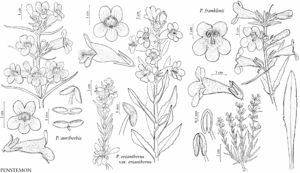Penstemon franklinii
Rhodora 95: 414, fig. 21. 1993.
Stems ascending to erect, 4–25 cm, retrorsely ± hairy proximally, glandular-pubescent distally. Leaves basal and cauline, not leathery, glabrous abaxially, retrorsely hairy adaxially, usually only along midvein on distal caulines; basal and proximal cauline petiolate, 12–73 × 2–9 mm, blade spatulate to oblanceolate, base tapered, margins entire or obscurely dentate, apex rounded to obtuse or acute; cauline 3–5 pairs, sessile, 11–48 × 2–6 mm, blade lanceolate, base clasping, margins entire or dentate proximally, apex acute to acuminate. Thyrses interrupted or continuous, cylindric, 2–7 cm, axis glandular-pubescent, verticillasters 3–7, cymes 3–5-flowered, 2 per node; proximal bracts lanceolate, 7–28 × 2–6 mm; peduncles and pedicels glandular-pubescent. Flowers: calyx lobes lanceolate, 4.8–7.5 × 0.9–1.9 mm, glandular-pubescent; corolla blue to bluish lavender or light purple, with purple nectar guides, funnelform, 14–20 mm, yellow-lanate internally abaxially, tube 4–6 mm, throat gradually inflated, not constricted at orifice, 5–7 mm diam., rounded or slightly 2-ridged abaxially; stamens: longer pair reaching orifice or exserted, pollen sacs parallel, navicular, 1.3–1.6 mm, dehiscing completely, sutures papillate; staminode 7–9 mm, included or reaching orifice, 0.7–0.9 mm diam., tip straight to recurved, distal 5–6 mm sparsely to densely pilose, hairs golden yellow, to 2 mm; style 8–10 mm. Capsules 6–10 × 3–5.5 mm.
Phenology: Flowering May–Jun.
Habitat: Sagebrush shrublands, grasslands.
Elevation: 1600–1800 m.
Discussion
Penstemon franklinii is known only from Cedar Valley in Iron County. According to Welsh, morphology and geography suggest that the species is most closely related to P. pinorum.
Selected References
None.
